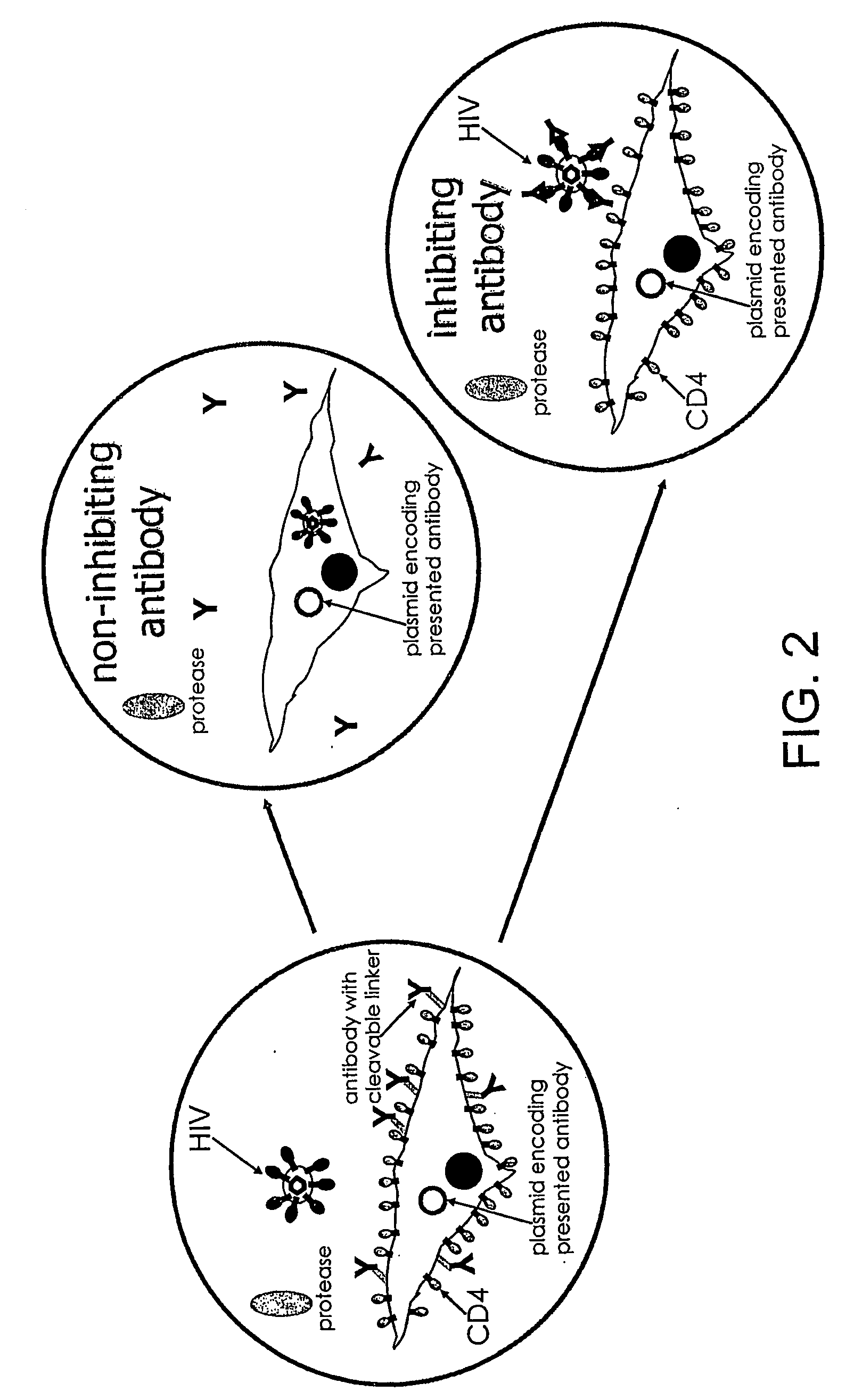Inhibitors of viral entry screening method
a screening method and virus technology, applied in the field of inhibitors of viral entry screening method, can solve the problems of inability to distinguish generally cytotoxic compounds, inability to detect viruses, and increasing the risk of other species such as humans, so as to reduce the selection of false positives, reduce or even eliminate false positives
- Summary
- Abstract
- Description
- Claims
- Application Information
AI Technical Summary
Benefits of technology
Problems solved by technology
Method used
Image
Examples
example 1
Small Molecule Screen for Inhibition of HIV Infection
[0156]In this example a compound library is screened for the ability to inhibit the infection of CD4-positive cells with the human immunodeficiency virus (HIV).
[0157]An indicator cell line is generated that stably expresses a reporter gene fused to the CD4-receptor. The reporter gene in this example is B-lac.
[0158]A wildtype CD4 receptor can be expressed additionally, if the fusion protein does not mediate cell-entry of HIV particles. In this example the CD4-B-lac fusion is functional in that the fused CD4 allows viral entry so that further expression of wildtype CD4 is not necessary.
[0159]One or more of the required coreceptors such as CXCR4, CCR5, etc. can be expressed to facilitate viral entry if required.
[0160]These indicator cells are seeded in microtiter plates and incubated with HIV-1 particles in presence of different compounds in each well.
[0161]B-lac activity is assessed by addition of substrate which is cleaved by B-lac...
example 2
Assay Using Psuedotyped Effector Particles
Overview
[0164]In this example, pseudotyped effector particles are used instead of wildtype virus. These are used to deliver a shRNA to inhibit expression of a reporter gene.
[0165]Applications of the invention using pseudotyped effector particles in this manner advantageously have broader application range than those using actual viruses as effector particles, since knowledge about virus-mediated downregulation of specific proteins is not required. The shRNA is designed to a specific reporter gene, and may even be purchased from commercial suppliers, saving further effort on the part of the operator. In addition, there a major safety benefits due to the fact that the application of non-replication competent particles, such as pseudotyped particles bearing shRNA loads, decreases the containment level required to conduct the assay.
Method
[0166]Recombinant MLV-derived pseudotype particles (effector particles) that have packaged a nucleic acid vec...
example 3
Selection of Candidate Inhibitors Expressed in Indicator Cells
[0170]Genetically encoded inhibitors such as antibodies or peptides are selected in a directed evolution approach. For this purpose, an indicator cell line expressing a library of inhibitors (candidate inhibitors of infection) and additionally a membrane-anchored affinity tag (reporter gene) is constructed.
[0171]Effector particles are used that have packaged a vector encoding shRNA raised against the affinity tag.
[0172]For selection, single indicator cells and effector particles are co-compartmentalised (in this example they are co-compartmentalised into aqueous droplets) and incubated to allow cell-entry of the effector particles.
[0173]In case of transduction / entry, the membrane anchored affinity tag will be downregulated by action of the shRNA.
[0174]In contrast, if a particular candidate inhibitor variant prevents cell-entry of the effector particles, the affinity tag will still be efficiently expressed.
[0175]This allow...
PUM
| Property | Measurement | Unit |
|---|---|---|
| Fluorescence | aaaaa | aaaaa |
Abstract
Description
Claims
Application Information
 Login to View More
Login to View More - R&D
- Intellectual Property
- Life Sciences
- Materials
- Tech Scout
- Unparalleled Data Quality
- Higher Quality Content
- 60% Fewer Hallucinations
Browse by: Latest US Patents, China's latest patents, Technical Efficacy Thesaurus, Application Domain, Technology Topic, Popular Technical Reports.
© 2025 PatSnap. All rights reserved.Legal|Privacy policy|Modern Slavery Act Transparency Statement|Sitemap|About US| Contact US: help@patsnap.com



